Class 11 - Physics
Chapter 5 - Laws of Motion
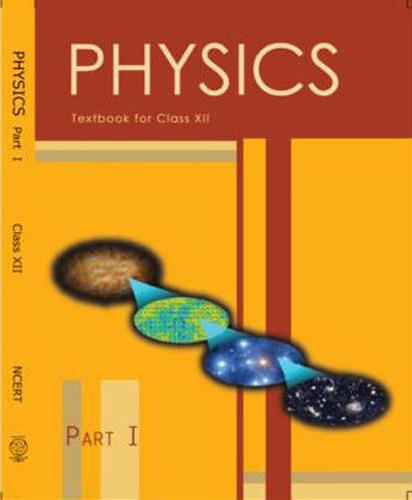
Top Block 1
Question :1.
Give the magnitude and direction of the net force acting on
(a) a drop of rain falling down with a constant speed,
(b) a cork of mass 10 g floating on water,
(c) a kite skilfully held stationary in the sky,
(d) a car moving with a constant velocity of 30 km/h on a rough road,
(e) a high-speed electron in space, far from all material objects, and free of electric and magnetic fields.
Answer :
- Net force =0. As the raindrop is falling with constant speed, therefore acceleration is 0 .As a result net force F = ma =0.
- Net force =0. The weight of the cork is acting downward. It is balanced by the buoyant force exerted by the water in the upward direction.
- Hence, no net force is acting on the floating cork.
- Net force =0. The kite is stationary in the sky, i.e., it is not moving at all.
Hence, as per Newton’s first law of motion, no net force is acting on the kite.
- Net force =0. The car is moving on a rough road with a constant velocity. Hence, its acceleration is zero.
- As per Newton’s second law of motion, no net force is acting on the car.
- Net force =0. The high speed electron is free from the influence of all fields. Hence, no net force is acting on the electron.
Question : 2.
A pebble of mass 0.05 kg is thrown vertically upwards. Give the direction and magnitude of the net force on the pebble,
(a) during its upward motion,
(b) during its downward motion,
(c) at the highest point where it is momentarily at rest. Do your answers change if the pebble was thrown at an angle of 45° with the horizontal direction?
Ignore air resistance.
Answer :
Whenever a body is thrown vertically upwards or vertically downwards, gravitational pull of the earth gives it uniform motion.
a=g = +9.8ms-2 in the downward direction.
Therefore in all three cases net force on the pebble is vertically downward.
Given:
Mass m = 0.05kg and a =+9.8m/s2
Therefore in all the 3 cases:
F =ma = (0.05 x 9.8)
=0.49N vertically downwards.
If the pebble is thrown at an angle of 45° with the horizontal, it will have both the horizontal and vertical components of velocity.
At the highest point, only the vertical component of velocity becomes zero.
However, the pebble will have the horizontal component of velocity throughout its motion.
This component of velocity produces no effect on the net force acting on the pebble.
Question : 3.
Give the magnitude and direction of the net force acting on a stone of mass
0.1 kg,
(a) just after it is dropped from the window of a stationary train,
(b) just after it is dropped from the window of a train running at a constant velocity of 36 km/h,
(c ) just after it is dropped from the window of a train accelerating with 1 ms-2,
(d) lying on the floor of a train which is accelerating with 1 ms-2, the stone being at rest relative to the train.
Neglect air resistance throughout.
Answer :
- Given: m=0.1kg, g=9.8m/s2, Net force F = ma = (0.1 x 9.8) = 0.98N.
This force acts vertically downwards.
- As the train is moving with constant velocity then acceleration =0. No force acts on the stone due to its motion.
- Therefore F (on the stone) =weight of the stone=mg= (0.1 x 9.8) =0.98N.
- Given that train is accelerating at the rate 1m/s2. Therefore net force F=ma (0.1 x 1) = 1N.
- This force is acting in the horizontal direction. Now, when the stone is dropped, the horizontal force F, stops acting on the stone.
- This is because of the fact that the force acting on a body at an instant depends on the situation at that instant and not on earlier situations.
- Therefore, the net force acting on the stone is given only by acceleration due to gravity. F = mg = 1 N This force acts vertically downward.
- The weight of the stone is balanced by the normal reaction of the floor. The only acceleration is provided by the horizontal motion of the train.
Acceleration of the train, a = 0.1 m/s2 .The net force acting on the stone will be in the direction of motion of the train. Its magnitude is given by:
F = ma = (0.1 × 1) = 0.1 N
Question :4.
One end of a string of length l is connected to a particle of mass m and the other to a small peg on a smooth horizontal table.
If the particle moves in a circle with speed v the net force on the particle (directed towards the centre) is:
(i) T, (ii) T – (mv2)/l, (iii) T + (mv2)/l, (iv) 0
T is the tension in the string. [Choose the correct alternative].
Answer :
Correct option: – (i) T.
The net force T on the particle is directed towards the centre. When a particle connected to a string revolves in a circular path around a centre,
the centripetal force is provided by the tension produced in the string. Hence, in the given case, the net force on the particle is the tension T, i.e.
F = T = (mv2)/ (l); Where F is the net force acting on the particle
Question : 5.
A constant retarding force of 50 N is applied to a body of mass 20 kg moving initially with a speed of 15 m s-1.
How long does the body take to stop?
Answer :
Given:
Retarding force, F = –50 N
Mass of the body, m = 20 kg
Initial velocity of the body, u = 15 m/s
Final velocity of the body, v = 0
Using Newton’s second law of motion, the acceleration (a) produced in the body can be calculated as:
F = ma
(–50) = 20 × a
Therefore a = (-50/20) = -2.5m/s2
Using the first equation of motion, the time (t) taken by the body to come to rest can be calculated as: v = u + at
Therefore t= (-u/a)
= (-1.5)/ (-2.5)
= 6 s
Question : 6.
Constant force acting on a body of mass 3.0 kg changes its speed from 2.0 ms-1 to 3.5 ms-1 in 25 s.
The direction of the motion of the body remains unchanged. What is the magnitude and direction of the force?
Answer :
Given:
Mass of the body = 3kg
Initial velocity u =2.0 ms-1
Final velocity v =3.5 ms-1
Time taken = 25sec
Using the first equation of motion, the acceleration (a) produced in the body can be calculated as:
v = u + at
Therefore, a = (v-u)/t
= (3.5 – 2)/ (25) = (1.5) / (25) = 0.06m/s2
As per Newton’s second law of motion, force is given as:
F = ma
= (3 × 0.06) = 0.18 N
Since the application of force does not change the direction of the body, the net force acting on the body is in the direction of its motion.
Question : 7.
A body of mass 5 kg is acted upon by two perpendicular forces 8 N and 6 N.
Give the magnitude and direction of the acceleration of the body.
Answer :
Given:
Mass of the body, m = 5kg
F1 = OA =8N
F2 = OB = 6N
Resultant force F = OC = √ (F1)2 + (F2)2
=√ (8)2 + (6)2
=10N
If
= (OB)/ (OA)
= (6/8)
=0.75
Therefore, θ = 36087
This is the direction of the resultant force, and the direction of acceleration will be:
a = (F/m) (Using F=ma by Newton’s second law of motion)
= (10/5) = 2m/s2
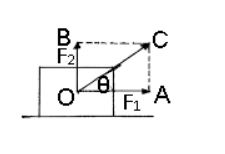
Question : 8.
The driver of a three-wheeler moving with a speed of 36 km/h sees a child standing in the middle of the road and brings
his vehicle to rest in 4.0 s just in time to save the child.
What is the average retarding force on the vehicle? The mass of the three-wheeler is 400 kg and the mass of the driver is 65 kg.
Answer :
Given:-
Initial speed of the three-wheeler, u = 36 km/h
Final speed of the three-wheeler, v = 10 m/s
Time, t = 4 s
Mass of the three-wheeler, m = 400 kg
Mass of the driver, m’ = 65 kg
Total mass of the system, M = 400 + 65 = 465 kg
Now, retarding force F = ma = (m (v-u)/t)
= ((465(0-10)/4))
=-11.625N.
Question : 9.
A rocket with a lift-off mass 20,000 kg is blasted upwards with an initial acceleration of 5.0 m -2.
Calculate the initial thrust (force) of the blast.
Answer :
Given:-
Mass of the rocket, m = 20,000 kg
Initial acceleration, a = 5 m/s2
Acceleration due to gravity, g = 10 m/s2
Using Newton’s second law of motion, the net force (thrust) acting on the rocket is given by the relation:
(F – mg) = ma
F = m (g + a)
= (20000 × (10 + 5)) = (20000 × 15) = 3 × 105 N
Question : 10.
A body of mass 0.40 kg moving initially with a constant speed of 10 m s-1 to the north is
subject to a constant force of 8.0 N directed towards the south for 30 s. Take the instant the force is applied to be t = 0,
the position of the body at that time to be x = 0, and predict its position at t = –5 s, 25 s, 100 s.
Answer :
Given:
Mass of the body, m = 0.40 kg
Initial speed of the body, u = 10 m/s due north
Force acting on the body, F = –8.0 N
Acceleration produced in the body, a= (F/m)
= (-8.0)/ (0.40)
=-20m/s2
- At t = –5 s
Acceleration, a1 = 0 and u = 10 m/s
s=ut + (1/2) a1t2
=10 x (-5)
=-50m
- At t=25s
Acceleration, a2= –20 m/s2 and u = 10 m/s
s1=ut + (1/2) a2t2
= (10×25) + (1/2) x (-20) x (25)2
=250 + 6250
=-6000m
- t=100s. It is divided into 2 parts, upto 30s
For 0≤ t ≤ 30s
A2 = –20 m/s2
u = 10 m/s
s2=ut + (1/2) a2t2
= (10 x 30) + (1/2) x (-20) x (30)2
= (300 -9000)
=-8700m
At t=30s, v=u+at
=10(-20) x 30
Velocity after 30sec =-590m/s
Therefore for motion from 30s to 100s
s3=ut + (1/2) a1t2
= (-590 x 70)
=-41300m
Therefore total distance s= s2+s3
= (-8700-41300)
=-50000m
Question : 11.
A truck starts from rest and accelerates uniformly at 2.0 m s-2. At t = 10 s,
a stone is dropped by a person standing on the top of the truck (6 m high from the ground).
What are the (a) velocity, and (b) acceleration of the stone at t = 11s? (Neglect air resistance.)
Answer :
Given:
Initial velocity of the truck as it starts from rest, u = 0
Acceleration, a = 2 m/s2
Time, t = 10 s
- Using first equation of motion, final velocity of the truck when the stone is dropped is given as:
v = u + at
= (0 + 2 × 10) = 20 m/s
The final velocity of the truck and hence, of the stone is 20 m/s.
- Horizontal velocity of the stone, when it is dropped at t = 11 s, is,
vx = 20 m/s it remains constant as there is no air resistance.
The vertical component (vy) of velocity of the stone is given as:
Initial velocity u=0, a = g =9.8m/s2
Time t = (11 -10) =1sec
From v =u+at
vy = (0 + 9.8 x 1) =9.8m/s-1
The resultant velocity (v) of the stone is given as:
v = √ (vx) 2 + (vy) 2
=√ (20)2 + (9.8)2
v= 22.3m/s
Let θ be the angle made by the resultant velocity with the horizontal component of velocity, vx
Therefore tan θ = (vy)/ (vx)
= (9.8)/ (20)
=0.49
Therefore θ = 290
- When the stone is dropped from the truck, the horizontal force acting on it becomes zero.
- However, the stone continues to move under the influence of gravity.
- Hence, the acceleration of the stone is 10 m/s2 and it acts vertically downward.
- Therefore path followed will be parabolic.
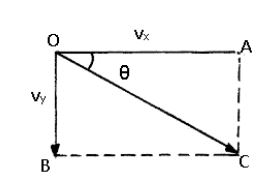
Mddle block 1
Question : 12.
A bob of mass 0.1 kg hung from the ceiling of a room by a string 2 m long is set into oscillation.
The speed of the bob at its mean position is 1 m s-1.
What is the trajectory of the bob if the string is cut when the bob is (a) at one of its extreme positions, (b) at its mean position?
Answer :
- At each extreme position, the velocity of the bob is zero. It is only under the influence of gravity at the extreme position.
- Therefore the bob will fall vertically on the ground.
- At each mean position, the velocity of the bob is 1 m/s along the tangent to the arc, which is in horizontal direction.
- If the string is cut at the mean position, the bob will behave as horizontal projectile hence, it will follow a parabolic path.
Question : 13.
A man of mass 70 kg stands on a weighing scale in a lift which is moving
(a) upwards with a uniform speed of 10 m s-1,
(b) downwards with a uniform acceleration of 5 m s-2,
(c) upwards with a uniform acceleration of 5 m s-2.
What would be the readings on the scale in each case?
(d) What would be the reading if the lift mechanism failed and it hurtled down freely under gravity?
Answer :
Given:
Mass of the man=70kg
Acceleration a = 0
Using Newton’s second law of motion, (R-mg) =ma; where ma = Force acting on the man
- As the lift is moving at a uniform speed of 10m/s, acceleration a =0
Therefore, R = mg
= (70x 10) = 700N
Therefore, reading on the weighing scale = (700/g) = (700/10) =70kg
- Lift is moving down with a uniform acceleration of 5m/s2.
Mass of the man, m = 70kg
Using Newton’s second law of motion,
(R + mg) = maR = m (g-a)
=70(10-5) = (70 x 5)
=350N
Therefore, reading on the weighing scale= (350/g) = (350/10) =35kg
- Lift is moving upward with uniform acceleration, a = 5m/s2
Using Newton’s second law of motion,
(R – mg) = ma
R =m (g+a)
=70(10+5)
= (70 x 15)
=1050N
Therefore, reading on the weighing scale= (150/g) = (1050/10)
=105kg
- If the lift mechanism fails and lift falls down freely then a =g.
Using Newton’s second law of motion,
(R + mg) = ma
R = m (g-a)
=m (g-g) =0
Therefore, reading on the weighing scale, = (0/g) = 0kg
The man will be in state of weightlessness.
Question : 14.
Figure 5.16 shows the position-time graph of a particle of mass 4 kg.
What is the (a) force on the particle for t < 0, t > 4 s, 0 < t < 4 s? (b) Impulse at t = 0 and t = 4 s? (Consider one-dimensional motion only).
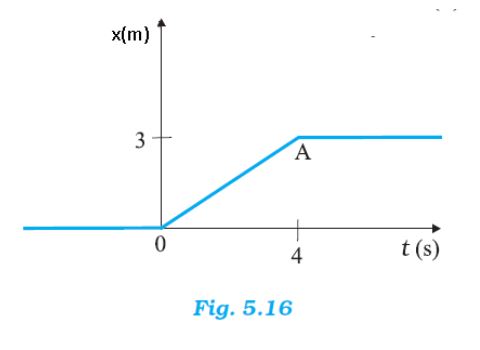
Answer :
- At t<0, the particle is not moving so no force will act on it. For t >4, x has constant value of 3m.T
- herefore as the body is at rest therefore no force acting on it.
During the interval 0<t<4, according to given figure the body is moving with constant speed.
Therefore there will be no acceleration as velocity of the particle is constant.
For t>4s, in the given graph, we can see that the position of the particle is parallel to the time axis.
This shows the particle is at rest at a distance of 3 m from the origin. Hence, no force is acting on the particle.
- At t = 0
Impulse = Change in momentum
= (mv – mu)
Mass of the particle, m = 4 kg
Initial velocity of the particle, u = 0
Final velocity of the particle = (3/4) m/s
Therefore, Impulse =4((3/4) -0) =3kgm/s
At t = 4 s
Before t=4s, particle has a constant velocity. u=0.75m/s
Initial velocity of the particle, u= (3/4) m/s
After t=4s, particle is at rest, i.e.
Final velocity of the particle, v = 0
Therefore, Impulse =4(0-(3/4)) = -3kgm/s
Question : 15.
Two bodies of masses 10 kg and 20 kg respectively kept on a smooth,
horizontal surface are tied to the ends of a light string. a horizontal force F = 600 N is applied to (i) A, (ii) B along the direction of string.
What is the tension in the string in each case?
Answer :
Given:
Horizontal force, F = 600 N
Mass of body A, m1 = 10 kg
Mass of body B, m2 = 20 kg
Total mass of the system, m = (m1 + m2) = 30 kg
Using Newton’s second law of motion, the acceleration (a) produced in the system can be calculated as:
F = ma
Therefore, a = (F/m)
= (600/30) =20m/s2
When force F is applied on body A:

(F – T) = m1a
T = (F – m1a)
Therefore T= (600 – 10 × 20) = 400 N…………. (i)
When force F is applied on body B:

(F – T) = m2a
T = (F – m2a)
Therefore T = 6(00 – 20 × 20) = 200 N………….. (ii)
Question : 16.
Two masses 8 kg and 12 kg are connected at the two ends of a light inextensible string that goes over a frictionless pulley.
Find the acceleration of the masses, and the tension in the string when the masses are released.
Answer :
Given:
Mass of smaller body m1 = 8kg
Mass of larger body m2 = 12kg
Tension in the string = T
Body having mass m2 having acceleration a moves downwards,
Body having mass m1 moves upward
Applying Newton’s second law of motion to the system of each mass:
For mass m1: The equation of motion can be written as:
(T – m1g) = m1a…………………… (i)
For mass m2: The equation of motion can be written as:
(m2g – T) = m2a……………………. (ii)
Adding equations (i) and (ii), we get:
(m2 – m1) g = (m1 +m2) a
Therefore, a = (m2 – m1)/ (m1 +m2) … (iii)
= (12 -8)/ (12 +8) x 10
= (4/20) x 10
=2m/s2
Therefore, the acceleration of the masses is 2 m/s2
Substituting the value of a in equation (ii), we get:
(m2g – T) = m2 ((m2 – m1)/ (m1 +m2)) g
T = (m2 – ((m2)2 – m1 m2)/ (m1 +m2))) g
= (2 (m1m2/m1) + m2) g
= (2 x 12 x 8)/ (12+8) x 10
= (2 x 12 x 8)/ (20) x 10 = 96N
Therefore, the tension in the string is 96 N.

Question : 17.
A nucleus is at rest in the laboratory frame of reference.
Show that if it disintegrates into two smaller nuclei, the products must move in opposite directions.
Answer :
Let,
Mass of parent nucleus = m (At rest)
Mass of two daughter nuclei= m1, and m2
Initial momentum of the system (parent nucleus) = 0
Let,
Velocity of first daughter nucleus having mass m1= v1
Velocity of second daughter nucleus having mass m2 = v2
Total linear momentum of the system after disintegration
= (m1v1 + m2 v2)
According to the law of conservation of momentum:
Total initial momentum = Total final momentum
0 = (m1v1 + m2 v2)
v1 = – (m2 v2)/ (m1)
Here, the negative sign indicates that the fragments of the parent nucleus move in directions opposite to each other.
Question : 18.
Two billiard balls each of mass 0.05 kg moving in opposite directions with speed 6 m s-1 collide and rebound with the same speed.
What is the impulse imparted to each ball due to the other?
Answer :
Given:-
Mass of each ball = 0.05 kg
Initial velocity of each ball = 6 m/s
Magnitude of the initial momentum of each ball, pi = 0.3 kg m/s
After collision, the balls change their directions of motion without changing the magnitudes of their velocity.
Final momentum of each ball, pf = –0.3 kg m/s
Impulse imparted to each ball = Change in the momentum of the system
= (pf – pi)
= (–0.3 – 0.3) = –0.6 kg m/s
The negative sign indicates that the impulses imparted to the balls are opposite in direction.
Question : 19.
A shell of mass 0.020 kg is fired by a gun of mass 100 kg. If the muzzle speed of the shell is 80 m s-1, what is the recoil speed of the gun?
Answer :
Given:-
Mass of the gun, M = 100 kg
Mass of the shell, m = 0.020 kg
Muzzle speed of the shell, v = 80 m/s
Recoil speed of the gun = V
Both the gun and the shell are at rest initially.
Initial momentum of the system = 0
Final momentum of the system = (mv – MV)
According to the law of conservation of momentum:
Final momentum = Initial momentum
(mv – MV) = 0
Therefore, V = – (mv)/ (M)
= – (0.020 x 80)/ (100 x 1000)
=- 0.016m/s
(-) ive sign shows that the gun moves in opposite direction of motion of the shell.
Question : 20.
A batsman deflects a ball by an angle of 45° without changing its initial speed which is equal to 54 km/h.
What is the impulse imparted to the ball? (Mass of the ball is 0.15 kg.)
Answer :

Mass of the ball m=0.15kg.
Speed of the ball u = 54km/h = 15m/s
Initial momentum of the ball = (mx v)
= (0.15 x 15) = 2.25kgm/s
The angle between the initial and final direction of the ball = 450
Horizontal component of the initial velocity = vcos θ along RO
Vertical component of the initial velocity = vsin θ along PO
Horizontal component of the final velocity = vcos θ along OS
Vertical component of the final velocity = vsin θ along OP
The horizontal components of velocities suffer no change. The vertical components of velocities are in the opposite directions.
∴Impulse imparted to the ball = Change in the linear momentum of the ball
= (mv cos θ – (-mv cos θ))
=2mvcos θ
Mass of the ball, m = 0.15 kg
Velocity of the ball, v = 54 km/h = 15 m/s
Therefore, Impulse = (2 × 0.15 × 15 cos 22.5°) = 4.16 kg m/s
Question : 21.
A stone of mass 0.25 kg tied to the end of a string is whirled round in a circle of radius 1.5 m with a speed of 40 rev. /min in a horizontal plane.
What is the tension in the string? What is the maximum speed with which the stone
can be whirled around if the string can withstand a maximum tension of 200 N?
Answer :
Given:-
Mass of the stone, m = 0.25 kg
Radius of the circle, r = 1.5 m
Number of revolution per second, n = (40/60) = (2/3) rps
Angular velocity, ω = (v/r) = 2πn….. (i)
The centripetal force for the stone is provided by the tension T, in the string, i.e.
T = Fcentripetel
= (mv2)/r = mrω2= mr (2πn) 2
= 0.25 x 1.5 x (2 x 3.14 x (2/3)) 2
=6.57N
Maximum tension in the string, Tmax = 200 N
Tmax = √ (m v2max)/(r)
Therefore, v = √ (Tmax x r)/ (m)
=√ (200 x 1.5)/ (0.25)
=√1200 = 34.64m/s
Therefore, the maximum speed of the stone is 34.64 m/s.
Question : 22.
If, in Exercise 5.21, the speed of the stone is increased beyond the maximum permissible value, and the string breaks suddenly,
which of the following correctly describes the trajectory of the stone after the string breaks:
(a) the stone moves radially outwards,
(b) the stone flies off tangentially from the instant the string breaks,
(c) the stone flies off at an angle with the tangent whose magnitude depends on the speed of the particle ?
Answer :
Correct option: – (b) the stone flies off tangentially from the instant the string breaks.
The velocity is tangential at each point of circular motion. When the string breaks, the particle
continues to move in tangential direction according to Newton’s first law of motion.
Question : 23.
Explain why
(a) A horse cannot pull a cart and run in empty space,
(b) Passengers are thrown forward from their seats when a speeding bus stops suddenly,
(c) It is easier to pull a lawn mower than to push it,
(d) A cricketer moves his hands backwards while holding a catch.
Answer :
- When a horse pushes the ground backwards with certain force at an angle. The ground offers an equal reaction in the opposite direction on the feet of the horse.
- The horizontal component of this reaction helps the cart to move in forward direction.
- In empty space, reaction force will be 0, so the horse won’t be able to pull the cart.
- When a speeding bus stops suddenly, the lower portion of a passenger’s body, which is in contact with the seat, suddenly comes to rest.
- However, the upper portion tends to remain in motion (as per the first law of motion).
- As a result, the passenger’s upper body is thrown forward in the direction in which the bus was moving.
- When a lawn mower moves the force is along the handle, which has two components.
- The force which is directed upwards i.e. vertical component reduces the weight of the mower and the horizontal component of the force helps to push the forward the mower.
- When a lawn mower is pushed, force is applied downwards and thereby, vertical component is directed downward, increasing the weight of the mower which won’t allow pushing the mower. So pushing of mower is difficult than pulling it.
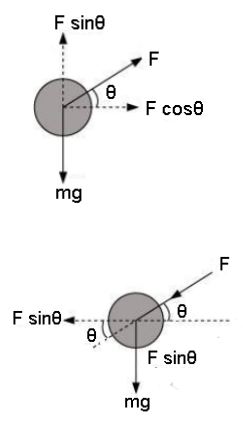
- When a cricketer holds a catch, the impulse received by the hands is equal to the product of the force exerted by the ball and the time taken (Fxt) to complete the catch.
- By moving the hands backwards, the cricketer increases the time of impact and the force exerted on his hands becomes much smaller and as a result it does not hurt him.
Bottom Block 3
Click here to visit Official CBSE website
Click here for NCERT solutions
Click here to visit Official Website of NCERT
Click here to download NCERT Textbooks
